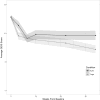Adjunctive yoga v. health education for persistent major depression: a randomized controlled trial
- PMID: 28382883
- PMCID: PMC5548599
- DOI: 10.1017/S0033291717000575
Adjunctive yoga v. health education for persistent major depression: a randomized controlled trial
Abstract
Background: The objective of this study was to determine whether hatha yoga is an efficacious adjunctive intervention for individuals with continued depressive symptoms despite antidepressant treatment.
Method: We conducted a randomized controlled trial of weekly yoga classes (n = 63) v. health education classes (Healthy Living Workshop; HLW; n = 59) in individuals with elevated depression symptoms and antidepressant medication use. HLW served as an attention-control group. The intervention period was 10 weeks, with follow-up assessments 3 and 6 months afterwards. The primary outcome was depression symptom severity assessed by blind rater at 10 weeks. Secondary outcomes included depression symptoms over the entire intervention and follow-up periods, social and role functioning, general health perceptions, pain, and physical functioning.
Results: At 10 weeks, we did not find a statistically significant difference between groups in depression symptoms (b = -0.82, s.e. = 0.88, p = 0.36). However, over the entire intervention and follow-up period, when controlling for baseline, yoga participants showed lower levels of depression than HLW participants (b = -1.38, s.e. = 0.57, p = 0.02). At 6-month follow-up, 51% of yoga participants demonstrated a response (⩾50% reduction in depression symptoms) compared with 31% of HLW participants (odds ratio = 2.31; p = 0.04). Yoga participants showed significantly better social and role functioning and general health perceptions over time.
Conclusions: Although we did not see a difference in depression symptoms at the end of the intervention period, yoga participants showed fewer depression symptoms over the entire follow-up period. Benefits of yoga may accumulate over time.
Keywords: Hatha yoga; major depression.
Conflict of interest statement
Figures
References
-
- Abrantes AM, McLaughlin N, Greenberg BD, Strong DR, Riebe D, Mancebo M, Rasmussen S, Desaulniers J, Brown RA. Design and Rationale for a Randomized Controlled Trial Testing the Efficacy of Aerobic Exercise for Patients with Obsessive-Compulsive Disorder. Mental Health and Physical Activity. 2012;5:155–165. - PMC - PubMed
-
- Babor TF, Higgins-Biddle JC, Saunders JB, Monteiro MG. AUDIT: The Alcohol Use Disorders Identification Test Guidelines for use in primary care. 2. World Health Organization; 2001.
-
- Barnes PM, Powell-Griner E, McFann K, Nahin RL. Complementary and alternative medicine use among adults: United States, 2002 Advance data from vital and health statistics; no 343. National Center for Health Statistics; Hyattsville, Maryland: 2004. - PubMed
-
- Bates D, Maechler M, Bolker BM, Walker S. Fitting linear mixed-effects models using lme4. Journal of Statistical Software. 2015;67:1–48.
Publication types
MeSH terms
Substances
Grants and funding
LinkOut - more resources
Full Text Sources
Other Literature Sources



